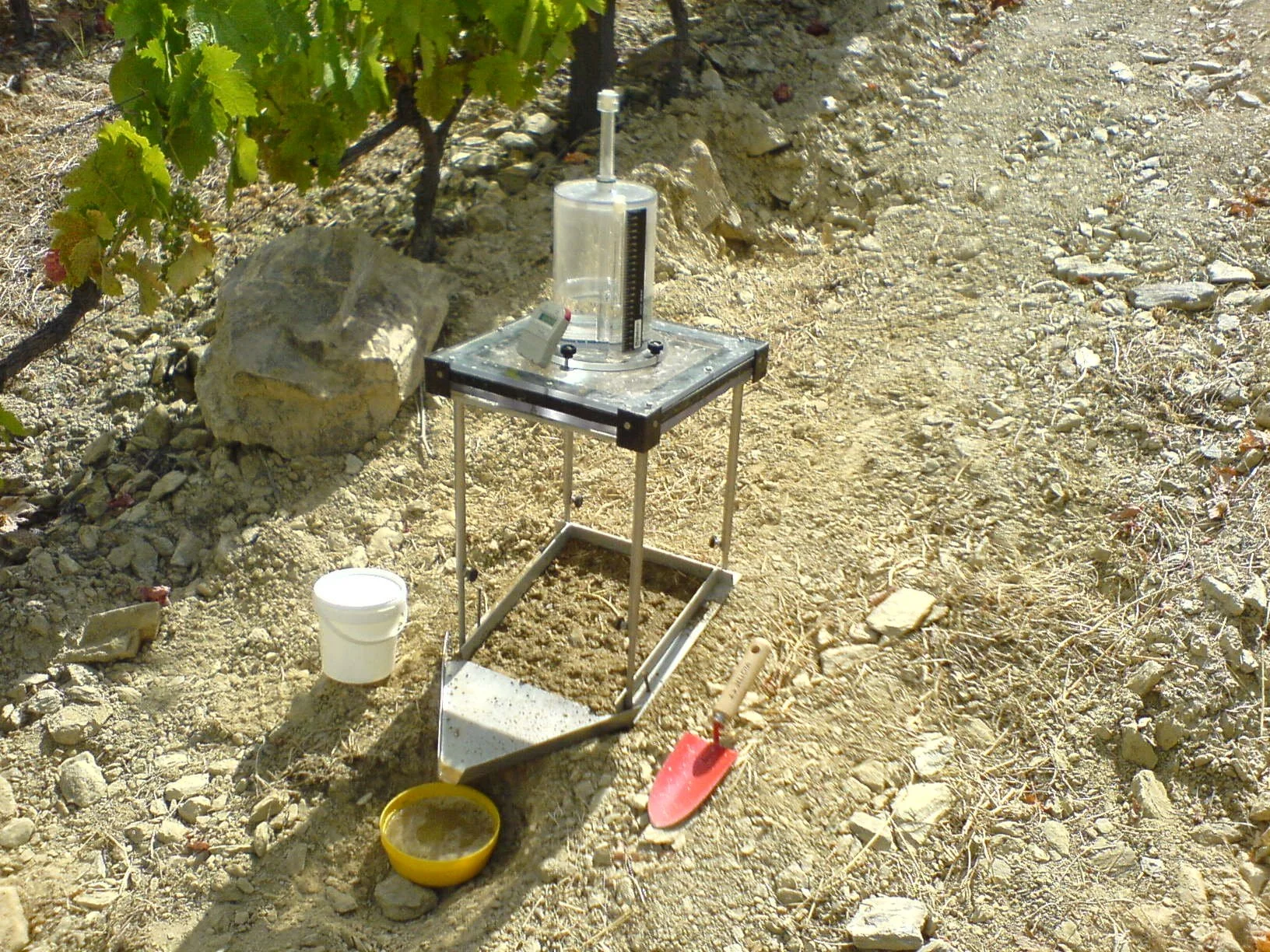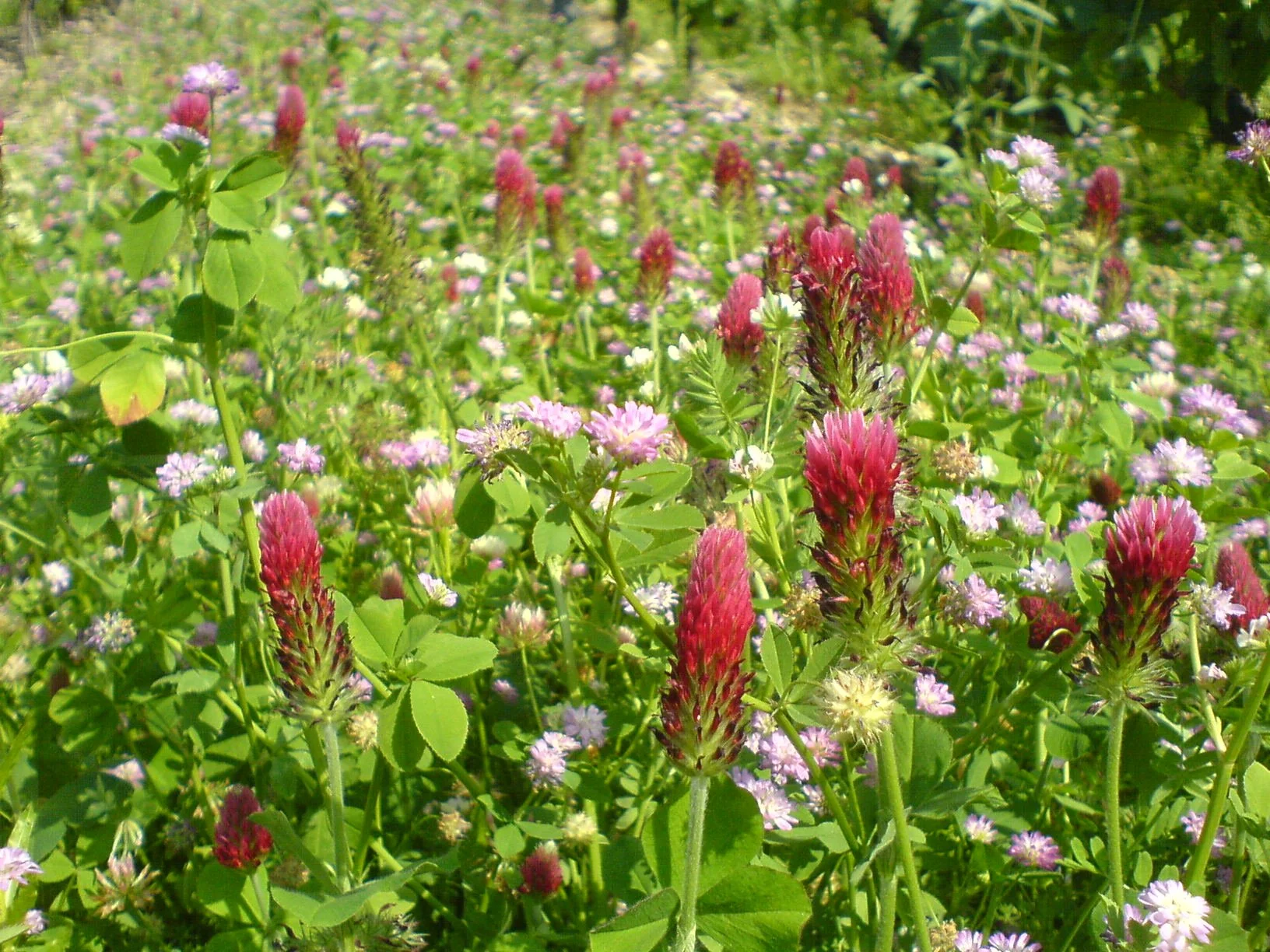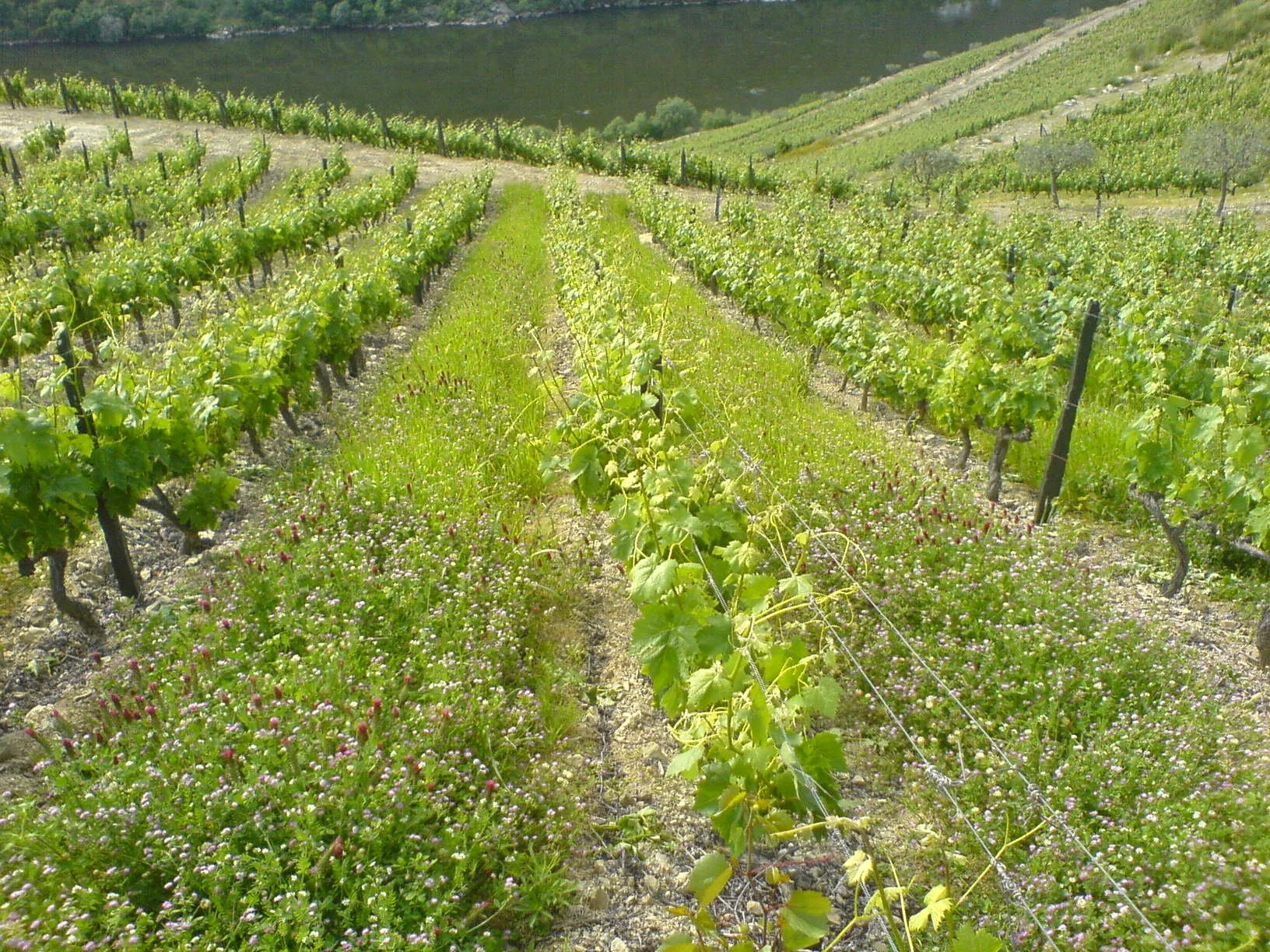'So, is your vineyard for sale then?'
When I worked in the Douro I was once approached by a chap who owned a property that bordered on one of ours, and he was understandably interested that ours might be coming on the market.
'No, not at all. Where did you hear that?'
'Well, it's just that it looks like it's been abandoned - all those weeds between the rows...'
Old habits die slowly, and obviously we were being quite innovative by introducing cover crops in a region where, at the time, conventional philosophy dictated that the only plants allowed in a vineyard were grapevines - and possibly the occasional olive tree.
But we were also saving a vast amount of herbicide, improving biodiversity, reducing erosion and providing a far better environment for the vines. The neighbour just needed to see it from a different point of view.
This piece is all about cover cropping (growing other plants in the inter-row space), and why it seems to be a brilliant idea. It's hard to think of any disadvantages.
So why was my neighbour so surprised?
There are two reasons.
Theoretically one would assume that, in a very hot and dry climate, any other vegetation in a vineyard would compete with the vines for scarce, precious water. Shortly we will see that it's quite the opposite, and it actually makes more water available for the grapes.
The other reason is that it might actually endanger the vines. This could happen in two ways:
Firstly, with inland climates (usually described as continental) there are large fluctuations in temperature between winter and summer. It gets very cold, and then very hot, unlike in maritime climates where the vast bulk of the adjacent oceans ensures relatively stable temperatures throughout the year due to the insulating effect of the water. This means that for us late frosts (after budburst) could potentially be a serious risk to the fragile young shoots on the vines. Low level cold air must be allowed to disperse, which is why we need a clean strip of soil underneath the rows of vines - so we will still need to apply a very much reduced quantity of herbicide, but only along a thin under-vine strip.
The second issue is again related to air circulation. Fungal diseases thrive on humidity so we like to allow breezes to waft between the vines to dry off damp leaves and bunches. This won't happen if the vines are shrouded by tall grasses up to the level of the fruit zone and it could seriously increase the risk of disease, hence the need again for a bare strip around the trunks of the vines.
But let's take a step back and look at the broader picture first. The pertinent question might actually be 'When did we even get the idea that vineyards must be a monoculture anyway?' As far back as the Old Testament vines happily coexisted with fig trees, olives, almonds, pomegranates and even blackberries (although I can assure you that having brambles in a vineyard is an absolute nightmare). In the Vinho Verde region in Northern Portugal vines are trained onto an overhead trellis around the edges of arable fields, providing shelter for the farmers from the almost incessant winter rain and protecting the farm tracks. Sometimes the vines are even trained up the trunks of trees, saving the need for a trellis. In the old, unmechanised vineyards of the Douro vines cohabit with citrus, almonds, olives and entire vegetable gardens. The efforts involved in building dry stone wall terraces by hand would be wasteful if every square foot wasn't put to productive use. One farmer I knew used to plant a crop of cabbages along the rows of newly planted vines - figuring that if was going to have to water them by hand anyway during the first year then he might as well have something to show for it.
The answer is in the word 'unmechanised'. The advent of tractors, ploughs and herbicide sprayers made weed control all too easy. Mechanical hedgers, pre-pruners and harvesters are incompatible with trees, tomatoes and potatoes in a vineyard. But what people didn't seem to realise was that tractor-drawn mowers also opened up another option with several significant advantages over bare soil. What if we could suppress and replace the weeds with something that was actually useful?
Managed correctly, cover crops offer a number of benefits. Let's start with erosion. Anyone who has been to the Douro will know that the vast majority of vineyards are planted on very steep slopes. Most of the tractors don't have wheels - they have to crawl on caterpillar tracks to handle the gradient. Every winter run-off from the vineyard turns the river the colour of milky tea (hence the romantic name d'ouro - the golden river). So much of the thin soil is being washed off the hills that some older vines on the lower slopes are now buried right up to the height of the cordon, with the bunches of grapes barely hanging much above the new ground level. This gradual accumulation of soil drags nutrients down the slope and retains far more water than the vines higher up in the same block have access to, creating huge differences in vigour and grape ripening. I've measured differences in probable alcohol of almost 3 % (i.e. the difference between an 11 % wine and a 14 % wine) along a single, steep 80 metre slope.
Soil erosion is primarily due to splashes from raindrop impact which dislodge grains of earth from the ground's surface, rather than the gullies that form afterwards, so naturally a protective layer of vegetation should in theory reduce their impact velocity, and also break up and slow down torrents of silty run-off. So I bought a piece of equipment called a rainfall simulator to find out if that was true.
Here's a picture of that gadget:
The very expensive rainfall simulator.
It's a very tiny (and very expensive) cold shower. You have to calibrate it quite carefully for the temperature of the water (it influences the flow rate, the scientists say...) and use a stopwatch (also in the photo) to create a tiny and very localised rain shower. The run-off is collected over a fixed period in the yellow bowl, which you then filter and dry, so you can weigh how much soil has been dislodged. Scale up the area and multiply by your average annual rainfall and you end up with an idea of how much topsoil could be lost to erosion - in our case around one and a half tonnes per hectare per year. With cover cropping, however, this figure was reduced by around 80 %, and in some cases no erosion whatsoever was detectable.
Qualifying note: I am of course aware that not all precipitation is of equal intensity, and that dry soils would be expected to respond differently from earth that is already damp. But it's big difference however you look at it. And the bowl doesn't have to be yellow, by the way.
Here's another interesting thing: the volume of the water collected in the bowl. On bare soil, we were re-capturing about 50 to 70 % of the total 'shower' as run-off, meaning that as little as 30 % of my simulated rainfall had been absorbed by the soil. In the cases where no erosion whatsoever was detected, it was because there had been no run-off at all. In other words, the cover crops allowed all of the water to be absorbed by the soil. The drops were running across the leaves, going down the stems and then straight into the ground. That's a very useful trick to increase infiltration in an arid climate.
This might come as a surprise, because any rational person would expect that growing a second crop in a vineyard would reduce the amount of water available to the vines. But this isn't the case if you choose cover crop species that are looking for the water at a different depth profile from the vines, and at a different time of year. We generally use a combination of clovers and gramineous species (grasses), such as ryegrass or oats - and preferably dwarf varieties that don't grow too high. Their roots are shallow, unlike those of the vines which go down many metres. When the cover crops are growing (from late autumn to late spring) the vines are either dormant, or using the winter rainfall that has infiltrated to a great depth some months earlier. The cover crops can only take their moisture from the surface.
Another way to ensure there is no competition is down to timing. I'll try to explain. Firstly, we sow the cover crops in October (but not every year - as the next paragraph explains) after the grape harvest but when the soils are still warm. Hopefully the autumn rains and residual heat will be enough for germination, to give us some protection against the heavy winter downpours. At this point the vines are dormant so they really don't need the water. By the time of budburst (mid-March) we should have a very good level of surface cover, and the clovers and grasses will probably start to flower in early April. We don't want this to happen yet though, because once they have flowered they will die back naturally, and we still need them to be around for a little longer. So we mow the cover crop, but high enough up to only remove the emerging flowers.
Within a month they will have been allowed to flower, on their second attempt, and then they start to dry out. We let the seeds fall (so they will self-sow to produce the next year's cover crop) and we mow again mid-May. By this stage of the year there won't be enough rain for them to bounce back, but we are left with a lovely thick natural mulch between the rows of vines. This straw-like covering shades the surface of the soil, keeping it considerably cooler, and it reduces air flow if it's windy - both of these factors dramatically reducing evaporation of soil water, leaving more of it for the vines.
I measured the soil water content under the mulch in June and July and found it to 21 % higher than in my control condition, which was bare soil. And here's the great thing: as it is gradually incorporated into the soil all this dead organic matter acts as a sponge, swelling up with water during the winter, and gradually releasing it to the vines in the summer. In addition to improving the soil structure, reducing compaction, it harbours beneficial microbes as well.
Whilst on the subject of biodiversity, two other effects stood out. When the clovers were flowering during the spring, both aesthetic and amazingly fragrant, the vineyards were literally buzzing. There were dozens of bees foraging per square metre, which surely is a good thing in these days of colony collapse disorder. Furthermore, we didn't need to use as many pesticides as the cover crop also harbours predatory insects that control some of the bugs that can attack the vines, especially leafhoppers.
Clover is brilliant for improving biodiversity in the vineyard.
Here's another cool thing: traditionally we would have sprayed the ground with herbicide just before budburst (so as to avoid the risk of weed killer getting onto green grapevine shoots). The problem is that a nasty beetle called the vine weevil, until now comfortably living and feeding amongst the weeds on the ground, suddenly finds itself short of lunch. So what does it do? It climbs up the trunk of the vines looking for food, just around budburst. The vines are now the only plants in the vineyard with green leaves, and once the weevil eats the buds, well - goodbye grapes. So you shouldn't steal a weevil's picnic if you can avoid it. But by leaving plenty of vegetation in the mid-row instead for it to eat, the buds are spared.
I mentioned earlier that we generally sow a mixture of clovers and ryegrass as our cover crop. There is a reason for this. Clovers are nitrogen fixers, and so effectively act as fertiliser, nourishing the vines. But too much vigour can be detrimental, so we try to balance it out. Remember the bit earlier on about nutrients accumulating at the bottom of the vineyards? Now look at the photo below.
Note the change in cover crop species halfway down the slope in order to control vine vigour.
The top part of the slope has been sown with clover alone, boosting its vigour. The bottom has more grasses, so we can actually correct imbalances in nutritional status within the vineyard with far more precision than we could with artificial fertilisers.
Note also that the cover crops have a net zero effect on soil mineral levels. Yes, nutrients are in stored in them during their growing season (sequestration), but then return to the soil as the crops decompose. Grapes, however, are removed from the vineyard each harvest (net exportation) so we will eventually need to apply some fertiliser. However, cover crops, albeit self-reseeded, don't last forever and eventually the desired balance between the species is likely to sway one way or another. Usually the grasses win. So every four years or so we apply fertiliser and plough it in, along with all the years of accumulated mulch, and re-sow the cover crop so it can start its good work all over again.
You, the wine lover, however will probably want to know if it makes any difference in the glass. Can we quantify the effects of cover cropping in the grapes or, more importantly, taste it in the wine? Should we be able to? Let's start with what we do know. The menthol characteristic often found in some Australian red wines is definitely caused by the presence of other vegetation in close proximity to vines. Eucalyptus trees release a volatile compound called 1,8-cineole (or eucalyptol) which has been detected in the skins of grapes and conclusively shown to increase the closer the vines are to the trees. So it is definitely feasible that vineyards cohabiting with another strongly perfumed plant species might show a similar effect.
The difficulty in untangling the research is that there are so many variables between the many studies that have been carried out. What species exist in the cover crop? How was it managed? Was it deliberately left active during the ripening season in order to compete with the vines to reduce their vigour, and therefore also have an effect on the size of the berries and the overall fruit yield at harvest? This would have a measurable impact on grape sugar levels, pH and titratable acidity. Unpicking the direct causational effects in each situation, and for each different aromatic molecule (and there are hundreds of them) becomes a very complicated question. For instance, if your cover crop is being used to reduce vine vigour then one would expect the vines to have fewer or smaller leaves. This in turn will also lead to a lower incidence of fungal diseases - which themselves have an effect on wine quality of course.
The long answer is very long, because the question is almost infinitely open.
The short answer is easier: Yes, on balance cover crops generally increase the amount of favourable volatile aromatic compounds in your wine glass. They make wine taste better too.
Better for the environment, better for the vines, better for the wines.
One final word: on a recent return to the Douro, I noticed that the neighbour's vineyard also appears to have been 'abandoned' now too, which brought a smile to my face...


